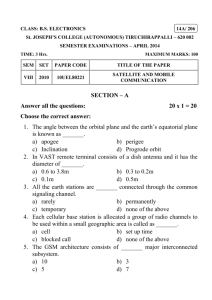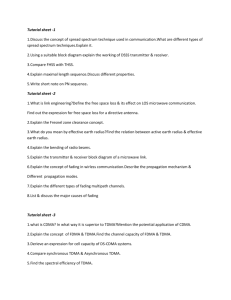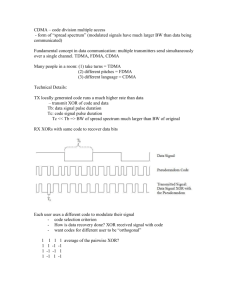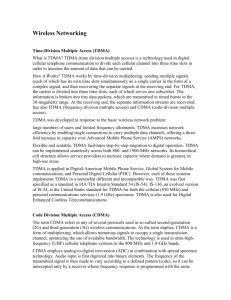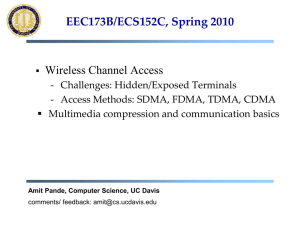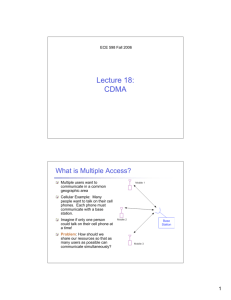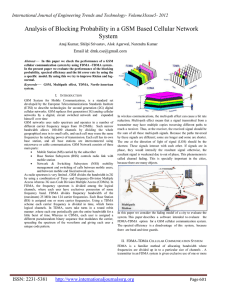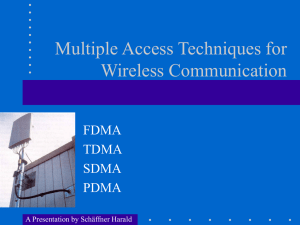Mobile Communication..
advertisement
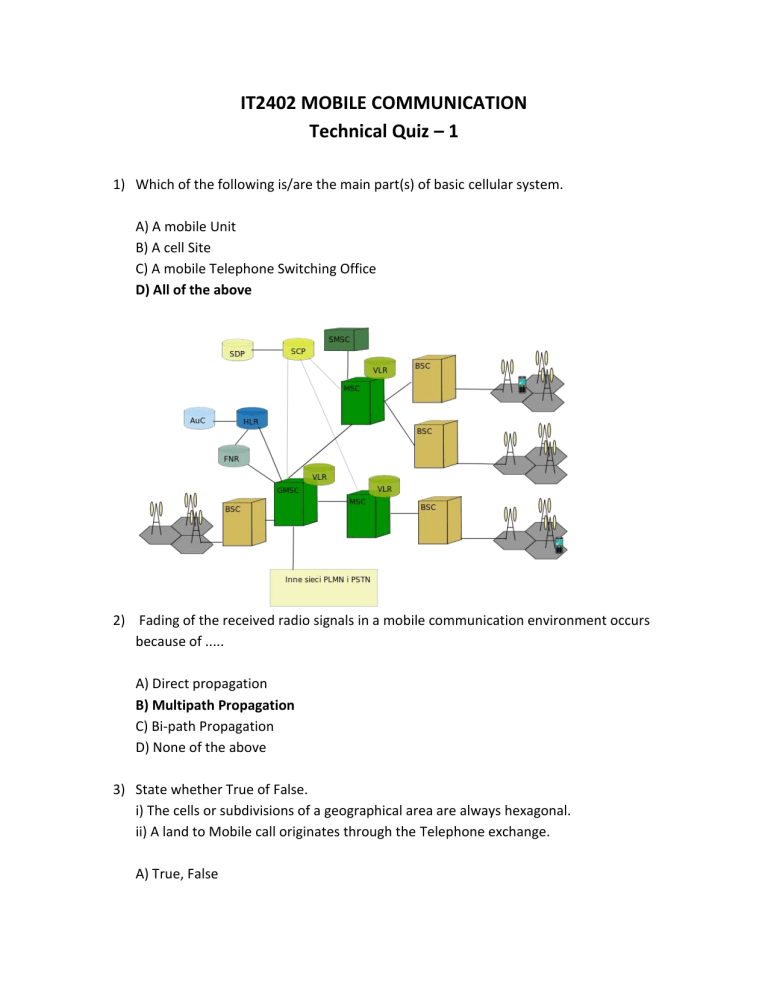
IT2402 MOBILE COMMUNICATION Technical Quiz – 1 1) Which of the following is/are the main part(s) of basic cellular system. A) A mobile Unit B) A cell Site C) A mobile Telephone Switching Office D) All of the above 2) Fading of the received radio signals in a mobile communication environment occurs because of ..... A) Direct propagation B) Multipath Propagation C) Bi-path Propagation D) None of the above 3) State whether True of False. i) The cells or subdivisions of a geographical area are always hexagonal. ii) A land to Mobile call originates through the Telephone exchange. A) True, False B) False, True C) False, False D) True, True 4) In .............. Frequency Spectrum is divided into smaller spectra and is allocated to each user. A) TDMA B) CDMA C) FDMA D) FGMA 5) In ................ multiple access is achieved by allocating different time slots for the different users. A) TDMA B) CDMA C) FDMA D) FGMA 6) State whether True of False. i) In GSM only TDMA is used. ii) There is zero inter-channel interference in CDMA. A) True, False B) False, True C) False, False D) True, True 7) The basic GSM is based on ____________________ traffic channels. A) connection oriented. B) connection less. C) packet switching. D) circuit switching. 8) ..................... are typically characterized by very small cells, especially in densely populated areas. A) 2G system. B) 3G system. C) 2.5G system. D) 3.5G system. 9) A antenna which attempts to direct all its energy in a particular direction is called as a ............. A) Directional Antenna B) One to One Antenna C) Propagation Antenna D) Single Direction Antenna 10) Which mode is used for installing networks in wireless communication device characteristics? A) Fixed and wired. B) Mobile and wired. C) Fixed and wired. D) Mobile and wireless. 11) In cellular networks, simultaneous users over the same channel is achieved by I. II. III. IV. A) B) C) D) Digital Technology. Frequency re-use. CDMA and TDMA. Using VLRs in each area and the HLR in the network switching centre. I and II I and III II and III IV only 12) CDMA technology is times efficient than TDMA A) 30 B) 40 C) 50 D) 90 13) FDMA technology efficiency reduced because of A) guard bands B) adjust channels C) spectrum D) none of the above 14) The efficiency of cellular modulation techniques depends up on A) power signal B) bandwidth C) channel capacity D) all of the above 15) In __________ frequency spectrum is divided into smaller spectra and is allocated to each user. A) FDMA B) TDMA C) CDMA D) SDMA 16) CDMA uses the idea of tolerating interference by __________ A) intelligent modulation B) Spread spectrum modulation C) manchester coding D) Bipolar non return to zero coding 17) In FDMA---------------- is asigned between the spectrum of two adjacent users. A) interferance band B) co-infer band C) Guard band D) inference band 18) FDMA is used mainly for ----------------------- transmission A) Digital B) Analog C) both analog and digital D) neither A) nor B) 19) TDMA stands for ------------------------ A) B) C) D) Time data mobile access Total disk multiple access Time division multiple Access Total data mainly access 20) The following concept refers to the use of radio channels on the same carrier frequency to cover different areas that are separated from one another by sufficient distances. A) frequency reuse B) handoff C) cell splitting D) cell geometry 21) The process of transferring an active call from one cell to another as the mobile unit moves from the first cell to the other cell without disconnecting the call. A) frequency reuse B) handoff C) cell splitting D) cell geometry 22) The interference received from co-channel cells is called A) co-channel interference B) frequency reuse C) handoff D) cell splitting 23) The actual radio coverage of a cell is known as ———— and is determined from the field measurements A) footprint B) cluster C) capacity D) channel 24) The following method is used as the access technology for global system for mobile (GSM) communications A) FDMA B) TDMA C) CDMA D) SDMA 25) The mobile technology using general packet radio service (GPRS) standard has been termed as A) 1G B) 2G C) 3G D) 2.5G 26) The cellular radio system that was mainly designed for digitized voice. A) 1G B) 2G C) 3G D) 2.5G 27) The mobile phone system that was analogue and it only carried voice traffic A. 1G B. 2G C. 3G D. 2.5G 28) The capacity of a cellular system is directly proportional to A. number of times a cluster is replicated in a fixed service area B. number of cells in the cluster C. Number of channels in the cell D. none of the above 29) The systems were “cellular” because coverage areas were split into ———— each of which is served by a low power transmitter and receiver. A. cells B. cluster C. capacity D. channels 30) Larger cells are more useful in ————. A. densely populated urban areas B. rural areas C. lightly populated urban areas D. mountainous areas 31) The following cellular technology will bring almost perfect real world wireless or called “WWWW World Wide Wireless Web” A. 1G B. 2G C. 3G D. 4G 32) The two 3G systems developed are A. GSM, CDMA B. AMPS, CDMA C. UMTS, IMT-2000 D. CDMAone, UMTS 33) ________ is used for allocating a separated space to users in wireless networks. A. SDMA. B. FDMA. C. TDMA. D. CDMA. 34) An even more fixed pattern that still allows some random access is exhibited by _________. A. slotted TDMA. B. reservation TDMA C. classical TDMA. D. TDMA. 35) WAP stands for _______. A. Wireless application protocol. B. Wired application protocol. C. Wired architecture protocol. D. Wireless architecture protocol. 36) WML specified as a/an _______. A. xml document type. B. html document type. C. wap document type. D. http document type. 37) The imode service was introduced in ____________. A. China. B. Europe. C. Japan. D. India. 38) I-mode service introduced in the ________ year. A. 1990. B. 1993. C. 1994. D. 1999. 39) Wireless Transaction protocol is on top of either ___________. A. WAP. B. WAP or WML. C. WTP. D. WDP or WTLS. 40) The technology aims at so called ad-hoc piconets is called ______. A. bluetooth technology. B. wap technology. C. ethernet technology. D. IEEE 802.11 technology 41) _______ supports WML, WML Script or both. A. WML user agent. B. WTA user agent. C. WAP gateway. D. WML gateway. 42) WML is based on the standard __________. A. html. B. http. C. cards. D. deck. 43) A WML document is made up of multiple ___________. A. deck. B. cards. C. pages. D. Files. 44) ___________ is specifically adapted to the wireless domain. A. MAC. B. CDM. C. TDM. D. FDM. 45) _________ comprises all algorithms allocating frequencies to transmission channels according to the FDM. A. SDMA. B. FDMA. C. TDMA. D. CDMA.
